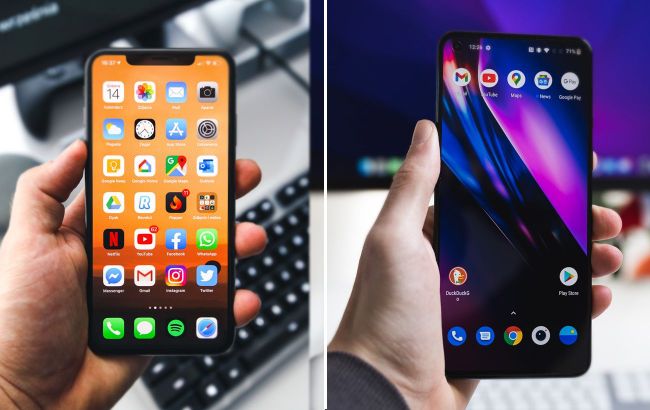10 functions that iPhone can borrow from Android
 What features could iPhone borrow from Android (collage: RBC-Ukraine)
What features could iPhone borrow from Android (collage: RBC-Ukraine)
Apple and Google have been borrowing many features from each other for many years. However, some are too good not to share. The iPhone can be enhanced with these fantastic Android features.
Here are 10 Android features that should make their way to the iPhone, making the use of the operating system more convenient.
Sources used in preparing the material include Android Police, Android Authority, and Business Insider.
Guest account
Our smartphones contain a vast amount of confidential information, ranging from personal photos to banking app data. What do you do when a friend asks to use your phone to make a call or a child wants to play?
Android-based smartphones support the addition of multiple users to the system. Each profile has a separate space for files, apps, settings, and so on. Simply switch the phone to guest mode, hand it over to someone else, and let them do what they need to do - they won't have access to your files. When they're done, you can easily delete the guest account.
In iOS, such a feature is not available. iPhones are designed for a single user. Technically, someone else can log in using their Apple ID on your device, but then you would have to sign out of your account and sign back in, which can be very inconvenient.
Storage expansion
One significant advantage of Android phones over Apple products is the ability to expand storage using microSD cards. This is particularly useful if you capture a lot of videos and photos.
Firstly, you can insert a card into the smartphone to expand the storage capacity. Secondly, with an SD card, copying dozens of gigabytes of information is faster. You won't have to wait long if you need to transfer a large amount of data from your smartphone to a laptop.
The iPhone has never had an external storage slot. Therefore, when the storage space on an Apple smartphone runs out, you can't simply add more memory. Instead, you have to purchase a model with a larger internal storage capacity, which tends to be noticeably more expensive.
App cloning
On Android smartphones, you can create clones of apps. This allows you to use multiple accounts even where support for numerous accounts was not initially provided. For example, if you need to log in to multiple WhatsApp accounts on one device, you can create a clone of the messenger and easily address the issue.
Some Android smartphone manufacturers, such as Samsung, OnePlus, and Xiaomi, have included app cloning as part of their firmware. On iPhones, however, this is not a feature you can utilize.
Fast charging
Android smartphones significantly outpace iPhones in terms of fast charging. The maximum speed of wired charging for the iPhone 15 Pro Max is limited to around 29 watts.
Meanwhile, manufacturers of Android devices continue to push the boundaries in developing fast-charging technologies. For instance, the OnePlus 11 supports 100-watt charging, allowing the battery to be almost fully charged in around 30 minutes.
The Redmi Note 12, with its included 210-watt charger, achieves this in just nine minutes.
The somewhat slower charging on iPhones is partly explained by Apple limiting the speed to support battery longevity. However, iPhone users often upgrade to a new device when a new model is released and do not wait for the battery to fully degrade.
In the meantime, the ability to almost fully charge your smartphone in 10-15 minutes can be a valuable feature, especially when on the go.
Reverse charging
Many Android smartphones support a feature called reverse wireless charging. This allows you to power up various accessories, such as headphone cases or smartwatches, by simply placing them on the back of the phone.
This feature is not exclusive to flagship devices; it's also found in mid-range devices like the Motorola Edge (2022) or the Nothing Phone 1. This is convenient as you don't need to search for an outlet and ask for a charger if your headphones run out of battery - you can charge them directly from your phone.
According to rumors, Apple is considering adding this feature to the iPhone at some point, but the exact timing is unknown. For now, aside from accessories like the MagSafe external battery, there are no other Apple-compatible accessories that support reverse wireless charging.
Fast and functional USB interface
When connected to a computer via a USB cable, the iPhone provides access only to photos and videos. Android smartphones, on the other hand, allow you to work with the entire internal memory. You can store music on your smartphone without using iTunes, transfer documents, installation files for apps, and other data.
Moreover, with a USB cable, you can connect an Android phone to the Android Auto system if it's available in your car. Or connect the smartphone to a desktop computer to use mobile internet. Sometimes, this can be very useful. However, the iPhone lacks such functionality.
Another weakness of the iPhone is the slow USB data transfer. Android smartphones with USB Type-C ports transmit data at speeds of 5 Gbps (USB 3.1 Gen 1) or 10 Gbps (USB 3.1 Gen 2). In contrast, both iPhone models with Lightning ports and the newer models in the 15th series with USB Type-C are limited to a speed of 480 Mbps (USB 2.0).
Foldable screens
Devices with foldable screens are becoming popular, and almost all of them operate on the Android platform. There are a few exceptions, such as the HP Spectre Fold and Asus Zenbook 17 Fold, which run on Windows.
Despite their high cost, the next-generation foldable devices have promising prospects. It's quite enjoyable to have the ability to unfold a smartphone, transforming it into a mini-tablet for reading books, browsing web pages, taking notes, and then folding it back and putting it in your pocket.
As of now, Apple does not have anything similar in its lineup.
Under-display camera
Another cool feature currently found only in Android smartphones is the under-display camera. This selfie module is hidden under a transparent AMOLED matrix and remains invisible until it is in use. Flagship devices like the Samsung Galaxy Z Fold 4 and Xiaomi Mi Mix 4 already feature this technology.
Thanks to under-display cameras, the smartphone display looks truly impressive with no punch holes or notches, just a large, clean screen.
Apple, on its smartphones, is trying to reduce the area occupied by the selfie camera and Face ID sensors on the front panels. For this purpose, the company transitioned from the notch to the island design with the iPhone 14 Pro, introduced in 2022. However, the cutout on the screen is still quite large, and no tricks with Dynamic Island can completely hide it.
Apple is actively working on developing under-display Face ID sensors, so in future models, the need for Dynamic Island may be eliminated. However, the company currently has no plans to move the selfie camera under the iPhone's display.
Under-display fingerprint scanner
Under-display cameras are a relatively new and not fully matured technology. On the other hand, many Android smartphones already boast under-display fingerprint scanners, a feature yet to be seen in iPhones.
Having the ability to unlock your device both through facial recognition and a fingerprint scanner is very convenient. This is especially handy when you take your smartphone out of your pocket for a glance without having to lift it to your face.
Moreover, paying with a smartphone equipped with a fingerprint scanner is often simpler. With Touch ID, you just need to bring the iPhone close to the card reader, touch the Home button with your finger, and you're done.
Using Face ID requires waking up the screen, and showing your face, and only then can you proceed with the payment.
There have been rumors that Apple is considering bringing back Touch ID to its smartphones and has even patented some sophisticated under-display scanners working in the shortwave infrared range. However, when iPhones will receive a feature that Android devices have had for several years is still a matter of speculation.
Increased zoom
The optical zoom capabilities of iPhone cameras are primarily limited to 3x, with the latest iPhone 15 Pro Max offering a 5x optical zoom. In contrast, flagship Android devices like the Samsung Galaxy S21 Ultra, S22 Ultra, S23 Ultra, and Huawei P40 Pro Plus boast cameras with 10x optical zoom.
When it comes to digital zoom, iPhones also fall behind their Android counterparts. The iPhone 15 Pro Max can only zoom in up to 25x, while the Samsung Galaxy S23 Ultra supports up to 100x, the Xiaomi 13 Pro up to 70x, the OPPO Reno 10 Pro Plus up to 120x, and the Google Pixel 7 Pro is equipped with a 30x digital zoom.
And we also wrote about 10 features that Android can borrow from the iPhone.

